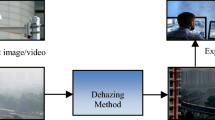Abstract
Stereoscopic images and video are synthesized from virtual views, which are produced from a real view and its depth map. However, this process involves a large amount of data which not only increases the transmission load, but also must be stored within the display devices which therefore must possess huge storage capacities. To solve these problems, the Joint Video Team has developed the 3D video coding (3DVC) standard to reduce the redundant data for multiview video and its depth map through the correlation between the real view and its corresponding depth map. When depth data in the 3DVC bitstream are lost during transmission, it causes the decoded depth map to be incomplete. Then the quality of the decoded depth map is reduced and the quality of the stereoscopic video will also be decreased. To increase the reconstructed quality of the damaged macro-block, this paper proposes an adaptive error concealment selection to determine the most suitable error concealment method based on fuzzy reasoning. The temporal and spatial correlations of the damaged macro-block which are defined by the motion vectors of neighboring blocks and their depth information are used for the adaptive selection. From the simulation result, the proposed algorithm can reduce the concealing time by at least 0.15–2.86 frame/sec and can improve quality by about 0.13–0.17 dB. The proposed algorithm is suitable for the 3DVC video transmission.






Similar content being viewed by others
References
Wiegand, T., Sullivan, G.J., Bjontegaard, G., Luthra, A.: Overview of the H.264/AVC video coding standard. IEEE Trans. Circuits Syst. Video Technol. 13(7), 560–576 (2003)
Schwarz, H., Marpe, D., Wiegand, T.: Overview of the scalable video coding extension of the H.264/AVC standard. IEEE Trans. Circuits Syst. Video Technol. 17(9), 1103–1120 (2007)
Aign, S., Fazel, K.: Temporal and spatial error concealment techniques for hierarchical MPEG-2 video codec. IEEE Int. Conf. Commun. 3, 1778–1783 (1995)
Criminisi, A., Perez, P., Toyama, K.: Object removal by exemplar-based inpainting. IEEE Comput. Soc. Conf. Compu. Vis. Pattern Recognit. 2, II-721–II-728 (2003)
Ghanbari, M., Seferidis, V.: Cell-loss concealment in ATM video codecs. IEEE Trans. Circuits Syst. Video Technol. 3(3), 238–247 (1993)
Lam, W.M., Reibman, A.R., Lui, B.: Recovery of lost or erroneously received motion vectors. IEEE Int. Conf. Acoust. Speech Signal Process. 5, 417–420 (1993)
Kung, W.Y., Kim, C.S., Kuo, C.C.J.: Spatial and temporal error concealment techniques for video transmission over noisy channels. IEEE Trans. Circuits Syst. Video Technol. 16(7), 789–803 (2006)
Lai, W.P., Liou, E.C.: Adaptive vector length interpolation for whole-frame error concealment of temporal MDC. IEEE Int. Conf. Adv. Commun. Technol. 9(8), 1136–1141 (2011)
Wu, G.L., Chen, C.Y., Wu, T.H., Chien, S.Y.: Efficient spatial-temporal error concealment algorithm and hardware architecture design for H.264/AVC. IEEE Trans. Circuits Syst. Video Technol. 20(11), 1409–1422 (2010)
Lee, P.J., Chen, H.H., Wang, W.J., Chien, L.G.: Feature-based error concealment for object-based video. IEICE Transa. Commun. E88-B(6), 2616–2626 (2005)
Liu, H.P., Wang, L.Y., Sun, F.C.: Mean-shift tracking using fuzzy coding histogram. Int. J. Fuzzy Syst. 16(4), 457–467 (2014)
Lee, P.J., Chang, H.K.: Fast mode decision using fuzzy logic for motion estimation in H.264/AVC video coding. Int. J. Fuzzy Syst. 10(4), 250–259 (2008)
Joint Draft 8.0 on Multiview Video Coding, JVT-AB204 (2008)
Miska M. Hannuksela, “Test Model for AVC based 3D video coding,” ISO/IEC JTC1/SC29/WG11 MPEG2012/N12558 (2012)
Author information
Authors and Affiliations
Corresponding author
Rights and permissions
About this article
Cite this article
Lee, PJ., Kuo, KT. An Adaptive Error Concealment Method for Depth Map in 3D Video Coding. Int. J. Fuzzy Syst. 18, 62–71 (2016). https://doi.org/10.1007/s40815-015-0097-1
Received:
Revised:
Accepted:
Published:
Issue Date:
DOI: https://doi.org/10.1007/s40815-015-0097-1




